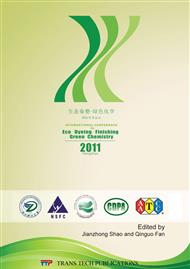p.1
p.5
p.10
p.16
p.23
p.28
p.33
p.44
Non-Formaldehyde Polyfunctional Crosslinking System for Cotton
Abstract:
Crosslinking of cotton with polycarboxylic acid, applied with catalysts based on phosphorus-containing inorganic acids, produces fabrics with excellent smooth-drying properties, which release no formaldehyde at any stage of preparation or on storage. If polycarboxylic acid has three or more carboxylic acid groups, the formation of such an anhydride can occur more than once and crosslinking of the cellulose molecule occurs. In our research work the use of an unsaturated bifunctional acid (maleic acid) and a phosphorus-containing inorganic compound (sodium hydroxyphosphinite) to obtain durable press finishing properties and flame retardant properties was studied.
Info:
Periodical:
Pages:
5-9
Citation:
Online since:
January 2012
Authors:
Keywords:
Price:
Сopyright:
© 2012 Trans Tech Publications Ltd. All Rights Reserved
Share:
Citation:


